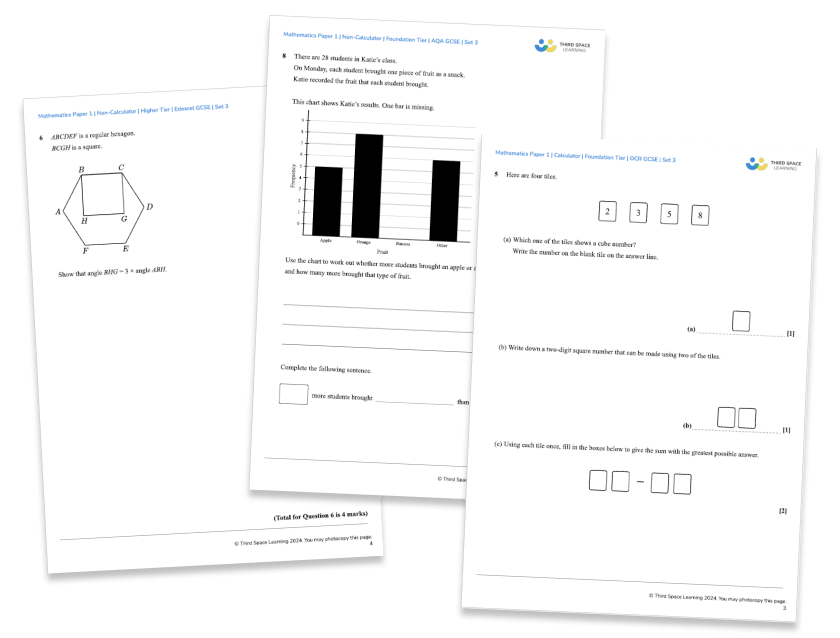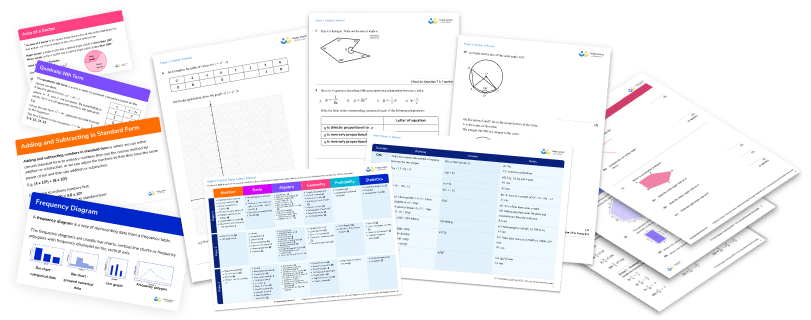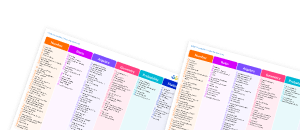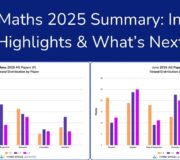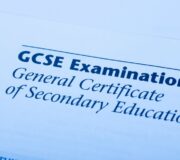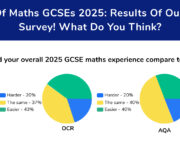GCSE Exams 2022 Advance Information For Maths: Summary, Guidance & Downloadable Topic Sheet (Edexcel, AQA, OCR)
This article was written to support teachers and students working towards GCSEs in 2022. For 2023 onwards the exam boards will not be supplying advanced information; all topics may tested as usual.
The keenly awaited maths advance information for GCSE exams 2022 has finally arrived. If the hustle and bustle of Twitter is anything to go by, we’re all ready to find out what this means for teachers, students and exams alike!
Here, we’ve asked one of our secondary maths consultants to provide some insight into what exam boards have shown us in their advance information, what this might mean for those of you teaching Year 11 maths this year, and what support is available.
As I’m sure you already know, GCSE exams (and A-Level exams) are being adapted in 2022 by exams regulator, Ofqual, and the Department for Education (DfE). This is part of a larger ‘safety net’ to reduce the impact of lockdown, closures and absences on students’ learning time in light of the coronavirus pandemic and Omicron, such as encouraging more generous grading by examiners, rather than the teacher assessed grades we saw in 2021.
To summarise, the adaptations for GCSE maths exams for the 2021-22 academic year are:
- A formulae sheet/equation sheet which will be available in the exam;
- Advance notice of certain topics that will appear on the summer’s exam papers.
This blog goes through the main points of the advance information, which was released on 7th February, and suggests ways this might be used to prepare young people for their exams to maximise success for GCSE results 2022.
GCSE Maths Topic List
Download our GCSE maths topic list for student revision for their exams. Includes step by step examples, practice and exam questions.
Download Free Now!Stay updated for 2026 GCSE season
Join our email list to be alerted to any new changes to GCSE maths exams in 2026.
We’ve got all the GCSE dates 2026 and we will be reviewing the contents of each of the GCSE maths papers in 2026 and taking a good look at the GCSE results 2026 in August.
Advance information for maths
Although the announced advance information is about the focus of exams for a variety of subjects, such as GCSE English literature, English language, combined science and art and design, we’ll focus solely on the choice of topics for maths.
Information in this article is taken directly from the websites of the three main exam boards (Edexcel, AQA and OCR) and interpreted to the best of my ability. I also offer some suggestions and opinions for applications to classroom practice and exam preparation.
Please note that the information in this article is an interpretation of the current picture and has not been endorsed by GCSE exam boards.
If you’re just interested in the free printable summary documents you can download them here: Advance Information Topic sheets for GCSE Maths 2022 (Edexcel, AQA, OCR)
Post-pandemic adaptations
All three main exam boards have followed a similar pattern for their advance information in line with this year’s pandemic-led adaptations.
- It is available for all papers, and for both Foundation and Higher tiers;
- The information is provided for each paper individually, and collated as a whole for the paper series;
- The topic descriptions are broad (e.g. Number; Fractions; Fractions of an amount);
- The topic descriptions are not in question order;
- There is a general sense from the guidance that the advance information will not apply to low-tariff questions, or to synoptic questions – this is discussed in more detail below;
- Advance information will not directly provide answers to other low-tariff questions.
Edexcel offers additional subject-specific guidance on their advance information, broadly summarised as follows:
- Students may need prior knowledge or skills that aren’t stated in the advance information;
- Students are still expected to apply knowledge to unfamiliar contexts.
Both Edexcel and AQA have stated that students will be “credited for using any relevant knowledge from any topic areas” when answering questions; this allows credit for alternative methods using knowledge and skills not explicitly stated in the advance information.
Do you need extra support covering certain topics before summer’s exams?
At Third Space Learning, we help prepare your KS4 students for success in GCSE maths through one-to-one AI tutoring lessons with Skye that diagnose (and plug) individual gaps, boost confidence, and address misconceptions. Our GCSE revision lessons are weekly, personalised, and designed for the students who need it most, especially those who might have been disproportionately affected by the coronavirus pandemic.
Our tailored GCSE tuition programme also consists of ‘crossover’ GCSE topics, which means they are relevant to students sitting either the Foundation or Higher paper!
Low-tariff questions
This terminology is used by both Edexcel and OCR in their guidance. AQA does not go into the same level of detail, but the Joint Council for Qualifications (JCQ) refers to the same ideas for low-tariff questions, so we can presume that this applies to the three main exam boards.
The JCQ states that, by ‘low-tariff’, they just mean questions attracting fewer marks. For maths, it is reasonable to conclude that these will be procedural questions on traditionally ‘lower end’ topics, usually attracting one or two marks.

Note that the advance material does contain references to topics that typically attract fewer marks.
For Foundation, this includes:
- Order of operations
- Fraction addition
- Percentages of amounts
For Higher, this includes:
- Solving linear equations
- Product of primes
- Four operations
Therefore, it’s reasonable to conclude that ‘easier’ topics appearing in the advance information will be assessed at a slightly higher level and be worth more marks.
This can be demonstrated in the following example concerning fractions of amounts.
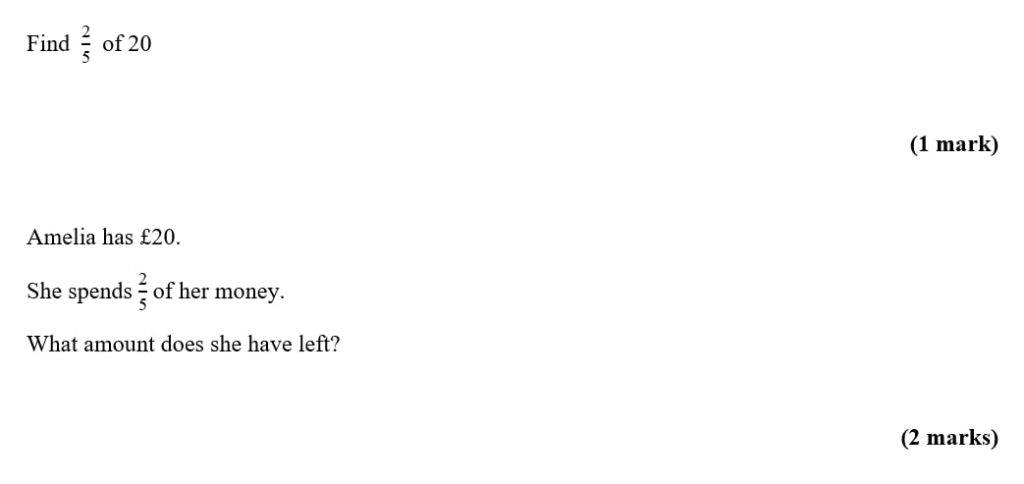
In the first problem, students operate procedurally to find the answer by dividing by 5 and multiplying by 2 . In the second problem, the operations carried out are the same, but a context-based answer is expected.
Let’s explore the statement that advance information won’t directly provide the answers to low-tariff questions in a bit more detail. For example, multiplying out brackets appears in the advance information for OCR Foundation Paper 2, and this will attract at least two marks. Therefore, it’s unlikely we’d see a one-mark question on expanding brackets such as ‘expand 2(x − 4) ’ on the same paper.
Please note that much of this section is my interpretation and best guesswork. Due to the lengths of the lists we’ve received from the exam boards, I would be surprised if every ‘easy’ topic on the advance information lists was assessed at the higher level discussed above.
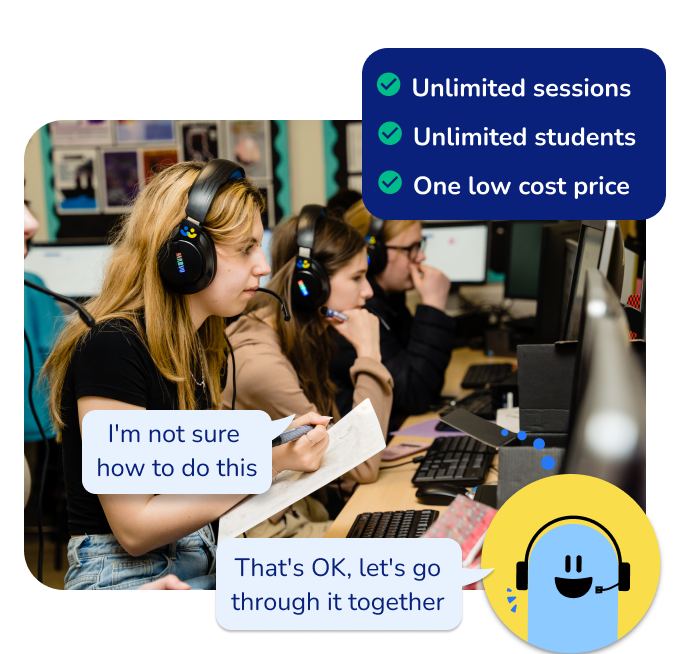
Unlimited GCSE maths tutoring with Skye, the voice-based AI maths tutor.
Built on the same principles, pedagogy and curriculum as our traditional tutoring but with more flexibility, reach and lower cost.
Help your GCSE students achieve their target grade with Skye’s one to one maths tutoring.
Watch Skye in actionSynoptic questions
A synoptic question is one that requires students to use and apply knowledge and skills from multiple topic areas.
GCSE maths exams do not explicitly have a synoptic assessment element in the way that some other specifications do. However, there is some degree of implicit synoptic assessment on the GCSE maths papers. These are questions that we probably refer to as ‘problem-solving’ with young people, where they are expected to identify and apply multiple strategies.

For example, in the problem above, students are required to form a quadratic from a non-standard presentation as a ratio.
In their general guidance, OCR explicitly states that “topics not included in the advance information may still be assessed in low tariff items or synoptic questions”.
Edexcel also discusses synoptic questions, stating that “teachers […] should bear in mind that prior learning in a key idea or topic area […] might be required for students to be able to answer questions fully. This is particularly the case, for instance, for synoptic questions”.
AQA does not specifically mention synoptic questions in their guidance, but we can presume they have taken a similar approach.
Both the JCQ and exam boards have been very clear that they don’t want the advance information to result in teaching a narrower range of content. When we look at specific guidance for maths, however, there is some implication that many of these deeper problem-solving questions will draw from the listed content.
For example, Edexcel states: “students’ responses to questions may draw upon knowledge, skills and understanding from across the content listed when responding to questions” (my emphasis).
AQA states: “students and teachers should consider how to revise other parts of the specification, for example to review whether other topics may provide knowledge which helps your understanding in relation to the areas being tested in June 2022″ (my emphasis).
My reading of this is as follows: while any topic from the specification could be required to answer deeper problem-solving questions, given the scope of the content lists produced by the exam boards, it is fairly likely that the majority of these questions will draw on elements from the advance information.
How to use the advance information
The aim of advance information, as stated by the DfE, is to support revision and communicate the focus of the examinations (or, in the case of maths, part of the examinations) for the GCSE 2022 dates.
It is not intended to narrow teaching or revision. Statements from the exam boards support this; it is crucial that we emphasise to students that this should be used to guide their revision focus, rather than as a definitive list of topics to revise.
As advance information does not apply to low-tariff questions, we can assume that, in maths, it gives an indication of:
- Easier topics requiring a higher level of thinking beyond one-step procedure;
- Harder topics asked in a fairly procedural manner;
- Multi-step questions in the same broad topic;
- More in-depth problem-solving requiring applications of listed topics, or combinations of listed topics, or their prior knowledge.
Combined content domain questions
The boards have stated that a given question may require content from more than one description, such as the following one, which requires students to apply knowledge of fractions and percentages of amounts.

There are a few other inferences we can draw from the advance information which might be useful for teaching. These will depend on the exam board you’re using and the tier of entry.
A focus for revision
For example, the collated content for Edexcel Foundation mentions Pythagoras’ theorem and exact trigonometric values but does not include an explicit mention of ‘trigonometry’ (as appears on the Higher guidance). From this, we might surmise that students are unlikely to be asked about trigonometry in right-angled triangles, particularly on the calculator papers, so this could be a topic to skim when revising, particularly for those aiming for a grade 4 or lower.
Foundation and Higher overlap
We can also consider the overlap between Foundation and Higher. Although assigning grade boundaries to topics is generally problematic, the crossover content questions are designed for students aiming for a grade 4 or 5, and so will be among the most challenging on the Foundation paper, and the least challenging on the Higher paper.
A topic appearing on both lists is not a guarantee that it will be assessed in the crossover section. For example, simplification appears in both Foundation and Higher lists for Edexcel; this is such a broad-reaching topic and I’d expect it to be assessed in different ways on each tier.
However, for topics such as error intervals, and standard form conversion and calculation, which appear on both Edexcel Foundation and Higher papers, these are likely to refer to the same question appearing on both tiers, which gives an indication of expected difficulty.
Advance information by exam board and tier
For the remainder of the article, I will look at the advance information from each board, by tier, across the maths curriculum, and give my immediate interpretation of the information. These are not designed to be in-depth analyses, but a starting point to begin drawing together ideas about what the papers may look like!
For each of these sections, summary tables will also be provided, both as images and as downloadable PDFs. Each table will cover the main GCSE maths topics:
- Number
- Ratio and proportion
- Algebra
- Geometry and measure
- Probability
- Statistics
At Third Space Learning, we’ve been busy creating a comprehensive GCSE maths library with a team of fully qualified expert secondary maths teachers.
Our content spans the whole curriculum and covers all major exam boards, consisting of both lessons and worksheets to tackle even the trickiest of advance information topics!
Our free lessons feature essential revision material, from step-by-step instructions and detailed examples, to practice questions and GCSE exam questions.
And if that wasn’t enough, our GCSE maths revision pages and all of our printable GCSE maths worksheets contain functional and applied reasoning questions, practice questions, exam-style questions and word problems.
Edexcel GCSE maths advance information
Foundation
Please note, topics in bold appear on both tiers, and some of these may include the overlapping GCSE maths questions that appear on both papers.
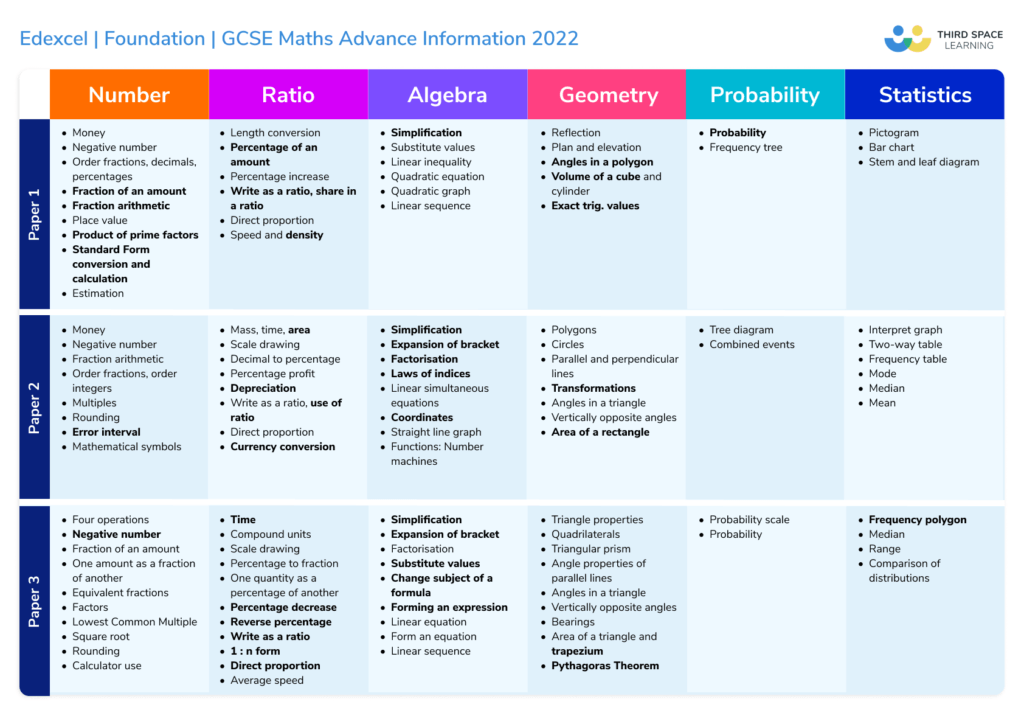
Number and ratio
From this list, it is likely that we’ll see a two-part standard form calculation question, with part (a) converting either to or from standard form, and part (b) carrying out a calculation on Paper 1.
I’d also expect a procedural product of prime factors question. Watch out for the error interval question on Paper 2, as students often get caught out by these! The other number skills named are pretty broad key skills for Foundation candidates.
Edexcel notes ‘overlap of topic areas’ with number. This is presumably as skills in the ratio section on the specification may be needed to answer some of the number questions, such as ordering fractions, decimals and percentages.
Direct proportion appears on all three papers, so it’s possible that this could include interpretation of a proportion equation, potentially linked to the straight line graph or currency conversion mentioned on Paper 2.
See also: Ratio Questions And Practice Problems
Algebra
On Foundation, many of these topics are likely to be assessed in a procedural manner, so this could be a good place to target some last-minute revision. I’d be including linear inequalities in all revision work on linear equations, ensuring that students aren’t put off by seeing that inequality symbol.
The ‘quadratic equation’ could be either solve by factorisation, or solve an equation in the form ax^{2} = b . Forming an expression followed by a linear equation could indicate a ‘form and solve’ type context-based question. As linear sequences appear twice in the series, I’d expect one to be finding the nth term.
See also: Algebra Questions And Practice Problems
Geometry and measure
A couple of nice steers here; it might be a good idea to begin memorising exact trig values with students now. As there’s no accompanying inclusion of ‘trigonometry’, it is probable that this is just stating an exact value.
Volume of a cylinder appearing on Paper 1 (non-calculator) indicates that students may need to be familiar with leaving their answer in terms of π.
See also: Trigonometry Questions And Practice Problems
Probability and statistics
Edexcel seems to like frequency trees, so it’s not a surprise to see this again. My Edexcel maths past papers blog observed that frequency trees appear on most exam series for the 2015 specification!
‘Probability’ as a statement is a bit wide-ranging to be massively useful, and students need to be familiar with basic probability skills anyway. Venn diagrams appear in the Higher list but are not included at Foundation, so this may be one to skim over.
In statistics, there is nothing surprising here – some straightforward topics in terms of charts and graphs to focus on for some (hopefully!) easier marks.
See also: Probability Questions And Practice Problems
Higher
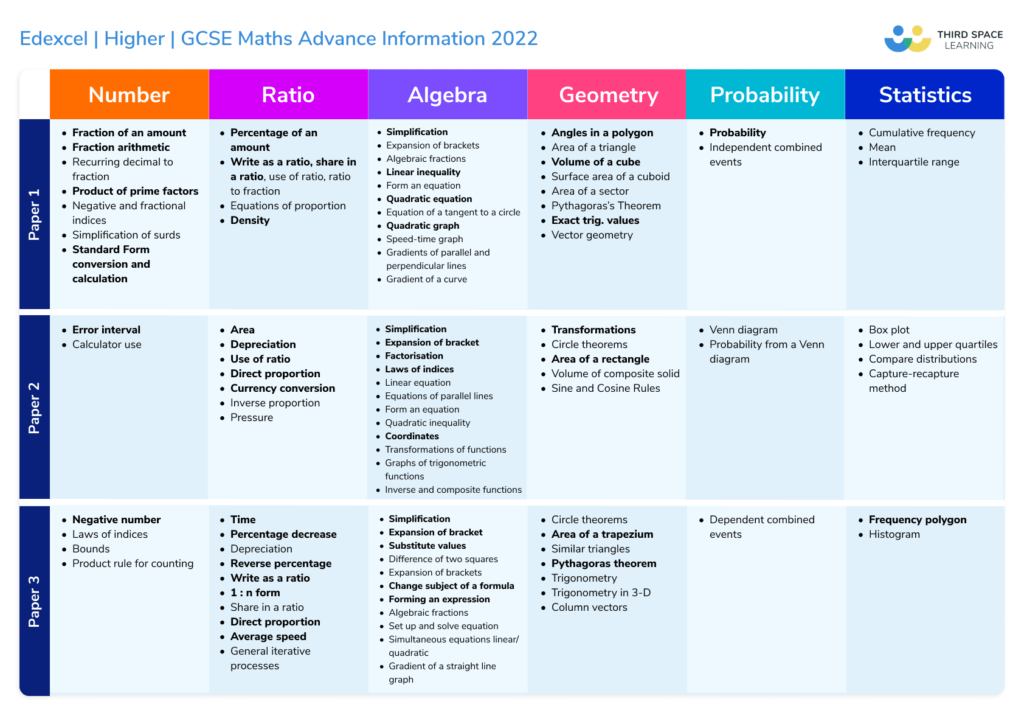
Number and ratio
Some of the more basic number and ratio skills also appear in the Foundation list, indicating that these are fairly likely to be included in the crossover questions, which appear on both papers. For example, there’s likely to be a product of primes question towards the start of Paper 1.
There are a few nice hints on straightforward topics to work on here, including simplifying surds and bounds. Paper 1 explicitly states ‘equations of proportion’, which may mean that the proportion work on Paper 2 is more context-based, or possibly graphical.
Algebra
There’s a pretty comprehensive list available for Higher. It’s looking like Paper 2 is going to have a good chunk of the Higher-level algebra.
‘Form an equation’ could require students to form the linear equation mentioned. As this isn’t in the crossover content, it’s likely to be towards the more difficult end of linear equations work.
Students always struggle with quadratic inequalities, so this is one to work on. ‘Expansion of bracket’ appears in the crossover content for Paper 3 and again in the Higher-only content as ‘expansion of brackets’, which could possibly be a quadratic or link to the difference of two squares mentioned.
Geometry and measure
Pythagoras’ theorem is on both lists, so this is likely to be a crossover question, potentially with a follow-up on right-angled triangle trigonometry. Other priority topics include circle theorems (appearing on Papers 2 and 3), vectors (Papers 1 and 3), and sine and cosine rules.
Probability and statistics
We don’t have the explicit statement of ‘tree diagrams’ as we do on Foundation, so it’s likely that the combined events problems won’t be given as tree diagram problems, although students might wish to use tree diagrams in their solutions.
Again, a good list for Higher statistics, with no real surprises or omissions. I would guess that the box plot question will also include quartiles and the distribution comparison, and it’s likely there’s an estimation of interquartile range (IQR) from a cumulative frequency graph.
Read more:
- Edexcel Maths Past Papers (Foundation)
- Edexcel Maths Higher Past Papers
AQA GCSE maths advance information
Foundation
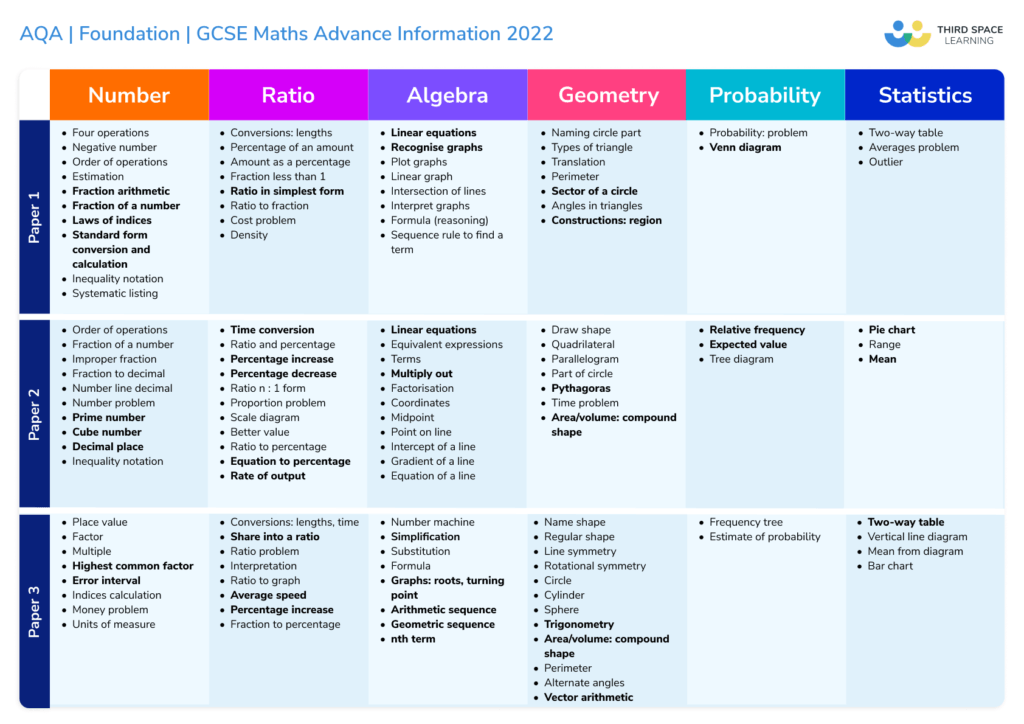
Number and ratio
While AQA’s guidance seems a little general, it’s worth noting the use of the word ‘problem’ in some of the statements. For example, Paper 2 states ‘proportion problem’, presumably implying there’s a context-based scenario.
There’s a handy list of applications in the ratio section, including cost, density, better value and rate of output, so I’d dig out some previous exam questions around these topics to practise with students.
Systematic listing and error intervals are a couple of number topics that sometimes get overlooked as newer content. It is likely that we’ll see a two-part standard form calculation question, with part (a) converting either to or from standard form, and part (b) carrying out a calculation on Paper 1.
Ratio n:1 form and scale drawings go nicely together; these could possibly be part of the same question.
Algebra
The first thing that jumped out at me in this strand is the amount of graph work, particularly on Paper 2. I suspect a question on graph shapes, and potentially plotting a quadratic (rather than a linear graph) on Paper 1, because linear graphs also appear on that paper and in some depth on Paper 2. There’s some crossover content on finding roots and turning point from a quadratic graph on Paper 3.
There’s also quite a bit on sequences on Paper 3. This is likely to be more crossover content, so I’d guess nth term of an arithmetic sequence, followed by some manipulation of a geometric sequence, possibly writing down the next two terms.
Geometry and measure
Area/volume of a compound shape appears on both Paper 2 and 3 (it’s not clear from the guidance whether it’s area or volume in either case).
There are a few statements just giving shape names; it’s possible that knowledge of these shape properties will be required to answer other questions, perhaps finding the volume of a cylinder on Paper 3, or naming a sphere.
Sector of a circle at Foundation is likely to be procedural and might be an easy win. It may help students to select correct methods if they know there’s a Pythagoras question to look out for on Paper 2 and some trigonometry on Paper 3.
Probability and statistics
There’s some fair detail in probability with topics like frequency trees, tree diagrams and Venn diagrams to focus on.
Relative frequency and expected value are likely to be assessed as part of the same question on experimental probability.
Two-way tables appear twice. There could be a link on Paper 1 with the probability problem, potentially requiring students to calculate a probability from a two-way table.
Higher
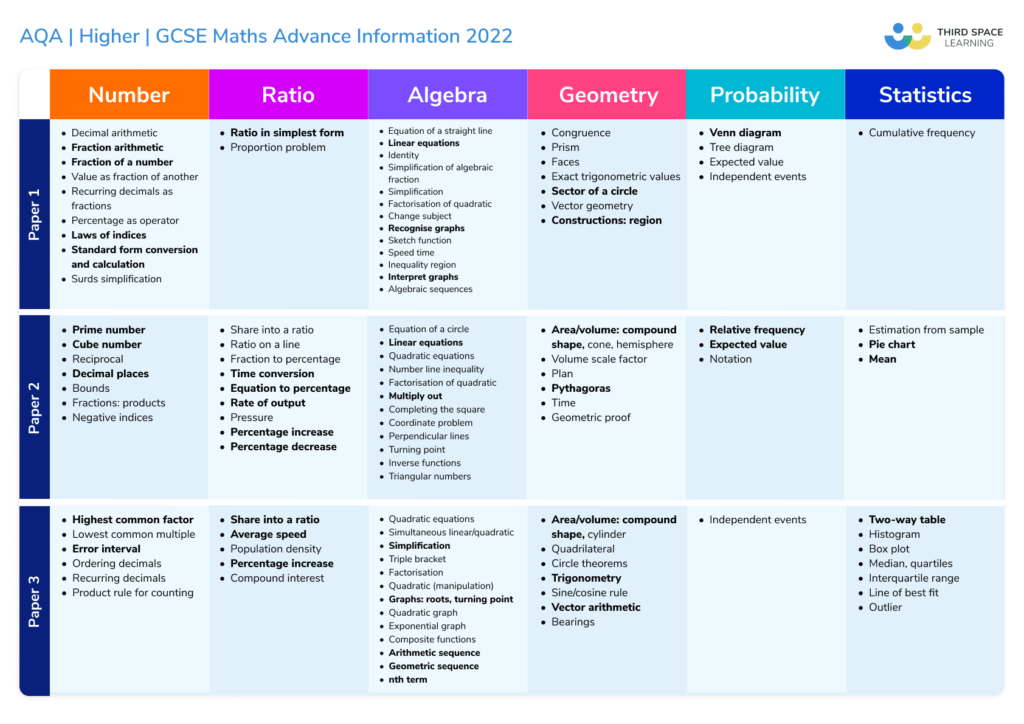
Number and ratio
Looking at the crossover content, there are likely to be a few fairly procedural questions on standard form conversions and calculations, fraction arithmetic, number properties, and HCF and LCM. Error intervals and the product rule for counting can both catch students out, so they’re worth a bit of revision.
It’s not particularly clear what the statement ‘fractions: products’ refers to; it’s unlikely to be simple fraction multiplication, as this would presumably be given as fraction arithmetic. My best guess at this point is that it refers to product of fractional gradients required for perpendicular lines.
In the ratio strand, the fact that share into a ratio isn’t in the crossover content, along with the inclusion of ratio on a line, makes me suspect that these two are linked to the geometrical proof question.
Algebra
There’s a broad range of algebra skills across all three papers. I’d be looking out for factorising a quadratic inequality to find a region on Paper 1.
On Paper 2, we’ve got completing the square (and a mention of turning points), and on Paper 3, the quadratic equation is likely to refer to the one involved in the linear/quadratic simultaneous equation. With all this work already on quadratics, I’d be surprised to see a quadratic formula question.
Triple brackets and inequalities on a number line might provide some easier marks; functions work can also be quite accessible, so it’s worth revising this with students.
Geometry and measure
As they’re in the crossover content, we can probably expect questions on sector of a circle, Pythagoras, trigonometry and vector arithmetic to be fairly accessible.
Area/volume of a compound shape appears on both Paper 2 and 3 (it’s not clear from the guidance whether it’s area or volume in either case), again in crossover content. It’s likely, therefore, that the volume scale factor question will involve either cones or hemispheres.
As bearings appear on Higher only, this could be an applied question linked with sine or cosine rule.
Probability and statistics
Venn diagrams, relative frequency and expected value are likely to be accessible as they appear in the crossover content. Tree diagrams are on Paper 1 and could tie in with independent events.
On Paper 2, the statement about notation is presumably the use of P() notation for probability and laws of probability given on the formula sheet.
Paper 3 has a nice long list of statistics content, so I’d get students to really focus on that in their last-minute preparation for the final paper. There’s a mention of line of best fit and outliers, so presumably, we’re looking at a scatter graph – students might need this pointing out!
OCR GCSE maths advance information
Foundation
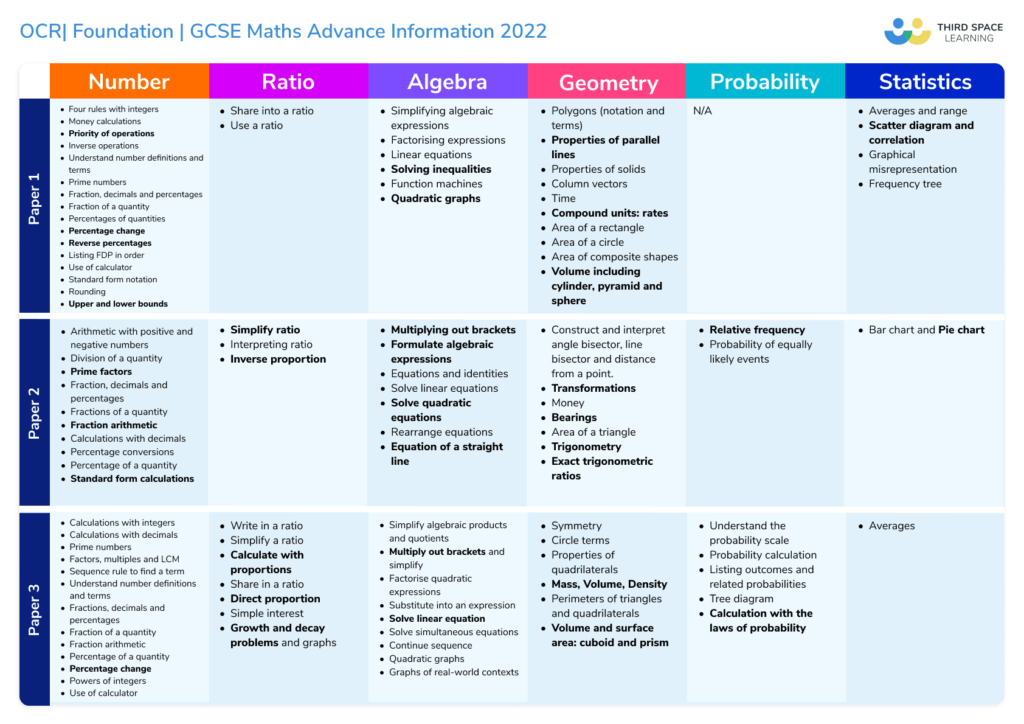
Number and ratio
The first thing to note about OCR’s advance information is that it’s significantly more difficult to identify crossover content due to non-standard terminology.
For example, it’s likely that ‘prime factors’ on Foundation reference the same question as ‘factors and multiples’ on Higher, but it’s definitely not as clear-cut as the other boards – this is perhaps by design!
The number lists are quite lengthy, and appear to list most of the topics on the specification. It’s likely that reverse percentages and lower and upper bounds will appear in the crossover content on Paper 1, and standard form calculations in the crossover content for Paper 2. Product of prime factors seems most likely to appear on Paper 2.
We have non-specific use of ratio and proportion on all three papers, with inverse proportion and direct proportion appearing in the crossover content for Papers 2 and 3 respectively.
Simple interest is worth reviewing with students before Paper 3, as some have a tendency to tackle every question mentioning interest as a compound change problem.
Algebra
The guidance for algebra is equally broad. Solving quadratic equations appears on the crossover content, so this is likely to be a factorisation where the coefficient of x^{2} is 1 .
Solving linear equations is mentioned a couple of times, and solving linear inequalities appears in the crossover content for Paper 1. Therefore, I would recommend including linear inequalities in all revision work on linear equations, ensuring that students aren’t put off by seeing the inequality symbol.
Graphs of real-world contexts on Paper 3 could link to the statement about ‘growth and decay problems and graphs’.
Geometry and measure
There’s quite a bit of area overall, with rectangle, triangle, composite and circle across the three papers. It’s likely that the ‘volume including cylinder, pyramid and sphere’ is crossover content, which implies we’re looking at a pyramid or sphere from the equivalent statement on Higher.
Pythagoras’ theorem isn’t mentioned anywhere in the Foundation information, although it does appear on the Higher Paper 1. However, there is quite a bit of focus on trigonometry, including exact trigonometric values in Paper 2.
There’s a reference to constructing loci on the Higher Paper 2; this could be referencing the same question as the constructions point regarding angle bisector and line bisector on Foundation.
Probability and statistics
There is no probability content given for Paper 1. There’s considerable overlap with Higher probability on Paper 2, which implies that the relative frequency question will be fairly challenging, possibly involving forming algebraic expressions.
Calculation with the laws of probability appears on Paper 3. It’s worth noting that students are given the laws on the formula sheet, but this will be extremely challenging for Foundation candidates.
In statistics, graphical misrepresentation appears a couple of times, as does averages. The crossover material contains scatter graphs and pie charts, hence the latter is likely to be assessed at a higher level.
Higher
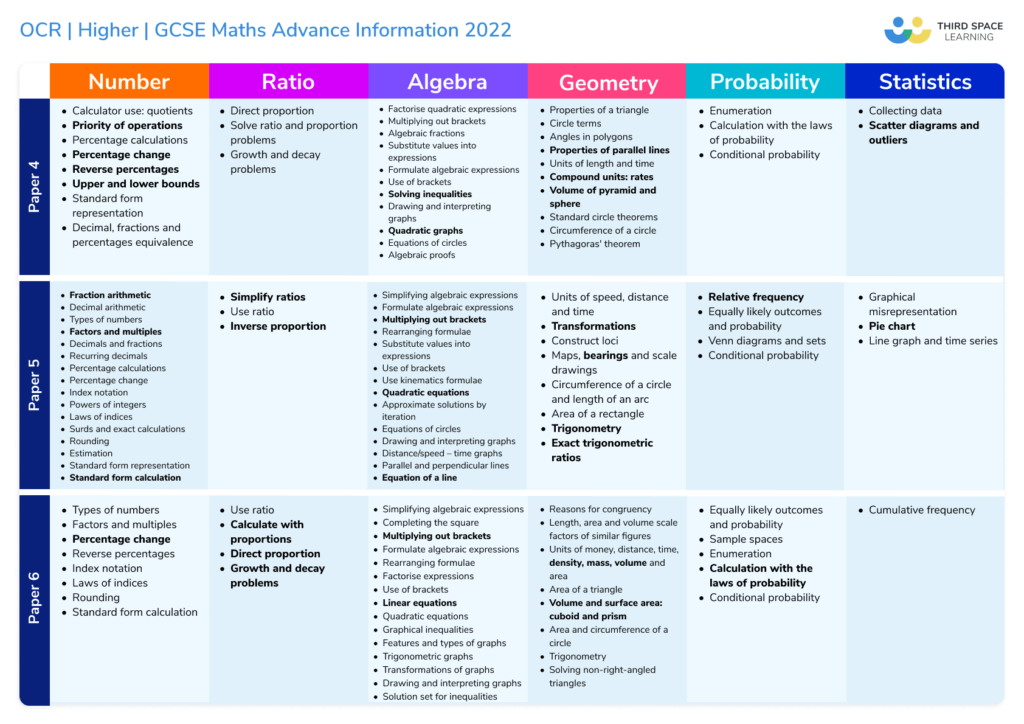
Number and ratio
Again, the number content from OCR lacks the specificity it needs to be particularly useful.
We’re likely to see some easier marks from the crossover content on each paper: order of operations, reverse percentages, upper and lower bounds, and standard form are a few examples. Surds appear on Paper 5, and there’s quite a bit of work across Papers 5 and 6 on the laws of indices.
Direct proportion and solving proportion problems appear on Paper 4; these are not in the crossover content, so I’d predict a proportion equations question, possibly linking to formulating algebraic expressions mentioned in the algebra section.
The proportional reasoning on Papers 5 and 6 is likely to be more accessible. There isn’t much detail on ratio other than ‘use ratio’ – so again, too broad to be particularly useful.
Algebra
The algebra lists are probably more useful on Higher. We’ve got a steer towards equations of circles and proof on Paper 4, and kinematics and iteration on Paper 5. The mention of graphical inequalities and solution set for inequalities, along with drawing and interpreting graphs on Paper 6 suggests we could expect a question on solving a more complex linear (or potentially quadratic) inequality and graphing the solution set.
The quadratic equations question on Paper 5 appears in the crossover content, so this is likely to be a factorisation where the coefficient of x^{2} is 1 . Remember that this can include difference of two squares!
Geometry and measure
A few key topics here include circle theorems, angles in polygons (likely interior or exterior angle calculations or reasoning), length, area and volume scale factors on Paper 6, possibly linked to area of a triangle.
Circumference of a circle is mentioned on all three papers – it’s possible that it’s linked with circle theorems on Paper 4, and likely to be arc length on Paper 5.
Pythagoras’ theorem isn’t mentioned anywhere in the Foundation information, so it’s likely that the reference on the Higher Paper 4 is a more challenging application. Trigonometry on Paper 5 is included in the crossover content, so should be fairly straightforward for most Higher candidates, but there’s a reference to trigonometry in non-right-angled triangles on Paper 6.
Probability and statistics
Conditional probability appears on all three papers. As calculation with laws of probability is mentioned on Paper 4, this is probably using the conditional probability law as given on the formula sheet. On Paper 5, the Venn diagrams question could potentially have a follow-up question involving conditional probability.
The detail for statistics seems lacking compared to the other two boards. Therefore, it’s difficult to draw any meaningful conclusions, beyond ensuring students have recently revised scatter graphs, pie charts, time series graphs and cumulative frequency. It is possible that the graphical misrepresentation questions will address some of the other chart types.
Further reading:
- JCQ Summer 2022 Arrangements
- AQA Changes For 2022
- Edexcel Summer 2022 Support
- OCR Changes For 2022
- 2022 GCSE Maths Paper 1
- GCSE Maths Paper 2
- GCSE Maths Paper 3
- What’s Next? Analysis of GCSE Maths Paper 1 2025
FAQs about GCSE exams 2022
There will be GCSE exams in 2022. Given that there haven’t been ‘standard’ exams since 2019, due to the coronavirus pandemic, advance information has been shared for various subjects, including GCSE maths. This consists of a formulae sheet and advance notice of certain topics.
On 7th February 2022, exam boards released advance information for GCSE exams 2022. This advance information aims to minimise the impact of COVID-19 on teaching, learning and exam preparation.
The adaptions for GCSE exams 2022 aim to support as many students in passing their GCSE maths exams as possible. Although the purpose of advance information is to support revision and communicate the focus of the exams, it is not intended to narrow teaching or revision.
DO YOU HAVE STUDENTS WHO NEED MORE SUPPORT IN MATHS?
Skye – our AI maths tutor built by teachers – gives students personalised one-to-one lessons that address learning gaps and build confidence.
Since 2013 we’ve taught over 2 million hours of maths lessons to more than 170,000 students to help them become fluent, able mathematicians.
Explore our AI maths tutoring or find out how a GCSE maths tutor could support students in your school.
